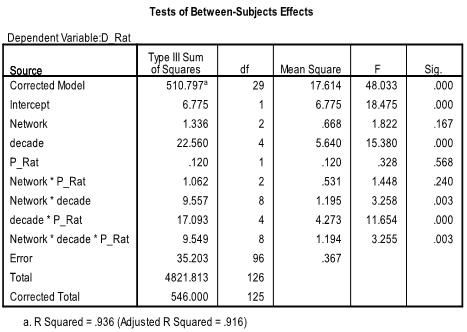I once previously examined primetime/daytime ratings overlap, but this is different. This analysis is more accurate, in some ways, than the overlapping slopes I presented before, for two reasons. First, this analysis breaks it down by network, and second, by now having coupled ratings for daytime and primetime in each season, we could more accurately examine actual year-by-year correlations.
We examined the association between primetime and daytime ratings (aggregate, averaged over all shows) for all networks from 1965 to 2009. I eliminated seasons before 1965 because, particularly for ABC, there was enormous initial variability as the networks grew.
What you see below is an analysis of variance table. The upshot of it is “the story is complicated”. The association between daytime and primetime ratings varied by network and by decade. But, look at that “R-squared” value, which says how much of the variance in daytime ratings we explained with this model: 94%. The legend, for the statistically minded: Dependent variable is Daytime Rating (D_Rat). Independent variables are Network, Decade, and Primetime Rating (P_Rat), and all possible interactions. (Click on the figure to see the full version, if it is truncated)

So, next, I examined the daytime/primetime associations separately by decade and network. The results look like this: (Click on the figure to see the full version, if it is truncated)

Now this is initially confusing, because it shows that the trends really varied by decade and network. “Green” means they changed together; “Red” means they did not or that primetime and daytime actually moved in opposite directions. The best way to visualize this is to look at the ratings, year-by-year, for daytime and primetime together. The next graphs show these: (Click on the figure to see the full version, if it is truncated)

Let’s note, overall, that a story I have told before – that soap ratings really began to decline almost from the beginning – is palpably obvious. ABC soaps grew through the early 70s, rebounded again with Gloria Monty’s GH, and then have declined ever after. In the 70s, ABC’s primetime lineup was growing at a faster rate than daytime…which was struggling with up-and-down. Just as ABC primetime was reaching heights (with Charlie’s Angels and Happy Days) its soaps were in descent. But then, beginning in the 1980s, ABC’s daytime and primetime lineups were yoked, falling in tandem. That association has broken a bit in the 2000s, as ABC primetime has experienced some upticks (Lost, Desperate Housewives, Dancing with the Stars) while the daypart has been on a linear decline trajectory.
For CBS, the story is quite similar. Remarkably, as you can see, the soap ratings were in decline through almost the entire period. That’s as close to a straight-line decline, for CBS daytime, as you’ll ever find. “OJ killed the soaps”. BALDERDASH. That slope of decline is remarkably constant since 1965, and don’t let anyone tell you otherwise. In contrast, CBS primetime was moving in almost the opposite direction all through the 1980s, as Carol Burnett and Mary Tyler Moore and Archie Bunker and their network compatriots created a grand era of gain and maintenance… There was a late 80s fall, then a massive early 90s rescue, then freefall in the early 1990s from which CBS primetime has never recovered. Thus, from about 1993, daytime and primetime fell together. But again, by the 2000s, as with ABC, we see a separation of trajectories. Primetime has managed relative stability (CSI anyone?), while daytime has been in linear decline.
Except in the 1970s, for NBC, daytime and primetime have been a pas de deux. NBC daytime has been in decline, steadily, since the early 1970s. So has primetime, except for slow growth and decline in the 1970s that was followed by the mid-80s revolution that Cosby, Family Ties, and Cheers achieved, along with the early-mid 90s rebound that ER brought.
Looking at both the graphs, and the table above, we see that daytime and primetime had yoked trajectories, more or less, in eight out of 15 “decade-by-network” cells. Moreover, the overlapping trajectories were greatest in the 1980s and 1990s, as larger forces of global, systemic decline drove both sets of ratings down. This association has actually been weakened a bit in the 2000s as, for two networks, the rate of decline for daytime has been somewhat steeper than primetime (for ABC and CBS).
This last fact is, in my opinion, somewhat ominous for daytime. Although viewers are being lost all over the dial, if primetime is has declined at a slightly lower rate, it would seem to suggest extra vulnerability for the soaps. Indeed, I think that may be part of the reason CBS lost patience with Guiding Light.

1 comment:
Thank you, Mark. I was the one at SON to ask the question about relationship between daytime and prime time ratings. I really appreciate you taking the time to do this analysis. It helped clarify some things for me and exploded some false assumptions that I had about the ratings. Keep up the good work. This is a great blog for people who love soaps!
I do have to say that I still don't understand some of the reasons why a soap will suddenly have a ratings spike and then fall just as suddenly (I'm talking day-to-day ratings). But I suppose that is one of the mysteries of life and soaps.
Thanks again!
Post a Comment